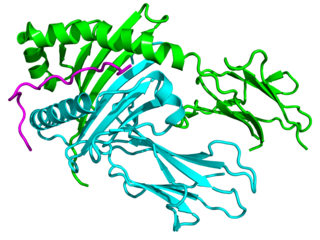
Major histocompatibility complex, class II, DQ beta 1, also known as HLA-DQB1, is a human gene and also denotes the genetic locus that contains this gene. The protein encoded by this gene is one of two proteins that are required to form the DQ heterodimer, a cell surface receptor essential to the function of the immune system.

Deleted in azoospermia protein 2 is a protein that in humans is encoded by the DAZ2 gene.

Olfactory receptor 1J4 is a protein that in humans is encoded by the OR1J4 gene.

Olfactory receptor 5K1 is a protein that in humans is encoded by the OR5K1 gene.

Olfactory receptor 5L2 is a protein that in humans is encoded by the OR5L2 gene.

Olfactory receptor 10G2 is a protein that in humans is encoded by the OR10G2 gene.

Olfactory receptor 4D1 is a protein that in humans is encoded by the OR4D1 gene.

Olfactory receptor 4E2 is a protein that in humans is encoded by the OR4E2 gene.

Olfactory receptor 7C1 is a protein that in humans is encoded by the OR7C1 gene.

Olfactory receptor 8B8 is a protein that in humans is encoded by the OR8B8 gene.

Olfactory receptor 8G1 is a protein that in humans is encoded by the OR8G1 gene.

Olfactory receptor 8G2 is a protein that in humans is encoded by the OR8G2 gene.

Olfactory receptor 1Q1 is a protein that in humans is encoded by the OR1Q1 gene.

Olfactory receptor 5J2 is a protein that in humans is encoded by the OR5J2 gene.

Serine/threonine-protein kinase MAK is an enzyme that in humans is encoded by the MAK gene.

UDP-glucuronosyltransferase 1-8 is an enzyme that in humans is encoded by the UGT1A8 gene.

Tripartite motif containing 69 is a protein that in humans is encoded by the TRIM69 gene.

Jumonji domain containing 1C is a protein that in humans is encoded by the JMJD1C gene.

PHD finger protein 7 is a protein that in humans is encoded by the PHF7 gene.

Coiled-coil domain-containing protein 181 (CCDC181) is a protein that in human is encoded by C1orf114, which is located at the Chromosome 1 at 1q24.2. The accession is Q5T1D7. Researches have recently revealed that CCDC 181 is a microtubule-binding protein that interacts with murine Hook1 in haploid male germ cells and localizes to the sperm tail and motile cilia. The disruption of Hook1 may lead to inappropriate function of spermatogenesis. The dysfunction may be related to the abnormal head shape of sperm or distinctive structural changes in flagella in sperm, which can result in male infertility. An increased rate of my gene has found in the haploid phase of male cell during meiosis, thus it is believed to relate to sperm cell and aid in spermatogenesis.
















